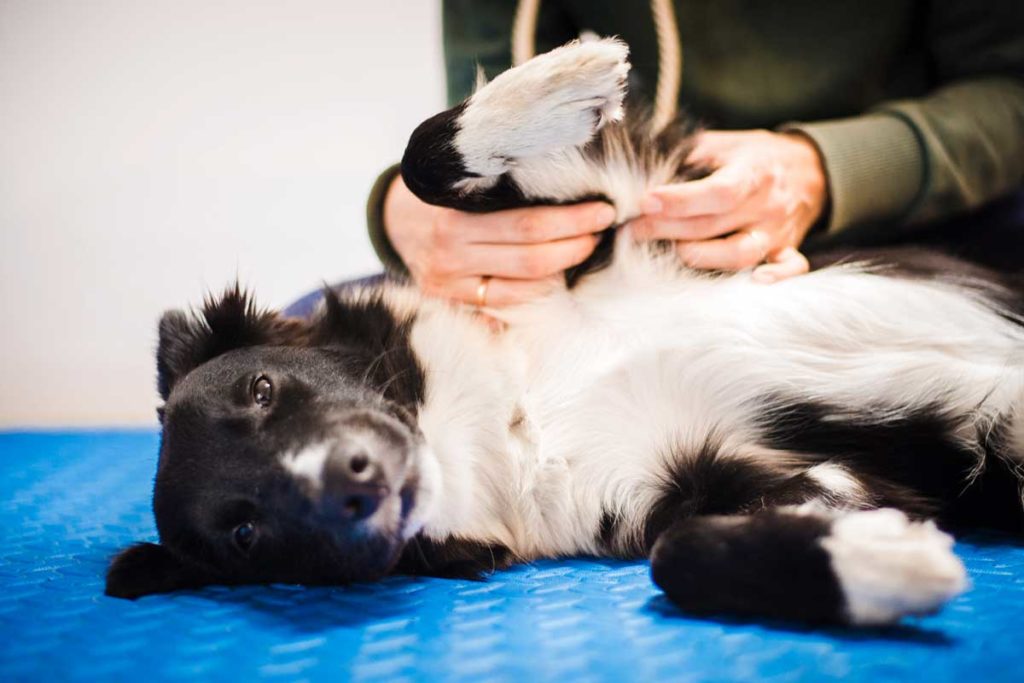If your joints and muscles get achy, you probably get a massage. Massage provides noticeable relief quickly. It’s relaxing, non-invasive, and doesn’t involve any medication. It’s the simplest natural solution to a common problem.
Now, consider your dog. Your dog is susceptible to the same aches and pains that you are. What do you do when your dog is dealing with muscle tension or joint discomfort? The answer is simple. You do the same thing you do for yourself: turn to massage therapy for relief.
Your dog will appreciate a massage just as much as you do. Here’s what you should know about the benefits of dog massage and techniques you can use to ease your dog’s tension.
What Are the Benefits of Dog Massage?
Dogs and people aren’t that different. Although we don’t look alike, we’re all made of the same components and can experience the same aches and discomforts.
The benefits of a canine massage session for your dog’s body are just about the same as the benefits for your body.
Improved Circulation
Swelling occurs when the body sends unique inflammatory markers to a muscle or joint, signaling to the body that the area needs healing. Improving circulation can help the body carry away waste products contributing to swelling.
This provides a slow trickle of relief that gets better with time. The more your massage the affected area, the easier it is to stay on top of recurring swelling.
Better Joint Mobility
Many pet massage techniques are designed to loosen up tense and sore muscles. By stimulating the muscles and eliminating the stiffness, you might see an improvement in your dog’s range of motion.
Their muscles and joints won’t feel as uncomfortably tight as before, improving their range of motion and making it easier for them to run and play.
Stimulated Healing Response
Massage therapy can naturally reduce swelling, especially when used regularly. Waste byproducts leave the muscles or joints, and freshly oxygenated blood is encouraged to replace it.
Tissue uses blood as food and fuel. In addition to carrying oxygen, it’s also carrying vitamins, minerals, and proteins that damaged tissues need to repair and replenish themselves.
A single massage is a good start, but it won’t entirely do the trick. When using massage therapy to promote healing, it’s important to stick to a regular massage schedule. Your dog’s veterinarian will be able to recommend an appropriate schedule.
Reduced Discomfort
Improved circulation combines with a stimulated healing response to produce reduced discomfort. It’s a simple equation.
Massage also helps to release happy endorphins in the brain that lead to increased feelings of relaxation. Endorphins address physical and mental tension, putting people and pets in a more comfortable state.
Better Sleep
The same endorphins that reduce discomfort also make it easier to sleep. Sleep is when your dog’s body does most of its healing.
The body must be entirely at rest to address inflammation, joint health issues, or muscle strain. If your dog has trouble getting comfortable enough to fall asleep and stay asleep, massage can help.
Will My Dog Benefit From Dog Massage?
Puppies generally won’t need dog massage. Older dogs and dogs with conditions affecting their joint or muscle health are most likely to experience the benefits of massage.
It’s important to keep in mind that massage isn’t a standalone treatment. While it’s an excellent supplementary treatment, it won’t replace a comprehensive treatment plant from your veterinarian.
If your dog is under the care of a veterinarian for a condition like canine arthritis or hip dysplasia, it’s important to follow your veterinarian’s instructions. Ask your veterinarian if you can incorporate massage into your dog’s care plan.
You’ll likely get some great advice about massage techniques and other things you can do to keep your dog feeling their best.
Do I Need a Dog Massage Therapist?
There are certified animal massage therapists who work specifically with animals. It may be the best option if you have the budget to use one. Just be sure that the person you choose has received formal training and is up to date with their certifications as a canine massage therapist.
Massage therapy for your pet can be pricey, especially since canine massage therapy takes multiple scheduled sessions to make a meaningful difference. Price won’t be a factor if you’re willing to learn a little.
You’ll get two great benefits if you’re comfortable performing the massage yourself. The first is that you’re saving time and money. The second is that you’re spending valuable bonding time with your dog, who might be more comfortable with your touch than a stranger’s.
If massage therapy is suitable for your dog, your veterinarian can probably teach you valuable therapeutic massage techniques. If you use a holistic veterinarian, chances are they’ll be supportive of massage therapy and happy to help you provide it for your dog.
How Do I Give My Dog a Massage?
Some dogs won’t like full-body massage. Other dogs will take to it quickly, especially if they’re affectionate or cuddly in their disposition. They’ll immediately know that the massage you’re giving them is an act of love, and they would probably let you go on for hours.
The Simplest Dog Massage Technique
Test the waters by applying gentle pressure in small circular motions along your dog’s neck and back. Gently and slowly increase the pressure, gently kneading the soft tissue on the sides of the spine.
You should only use light pressure. Very firm pressure may harm your dog, especially if they’re a small or toy breed. If your dog enjoys or wants firm pressure, they may lean into your hand as a way to tell you that it feels good. Let your dog take the lead.
Slowly work your way down your dog’s back to their tail, and let the massage travel down their hips and back legs. Continue to use circular motions.
How Long To Massage Your Dog
It should take five to 10 minutes to give your dog a massage. Small dogs will take less time to massage due to their overall body size.
If your dog loves the massage and you’ve got time to bond, you can go for as long as your dog lets you. There is no upper limit.
How Often To Massage Your Dog
Plan to give your dog at least one massage a week. The benefits will begin after the first massage, but greater relief can be found through consistency. If your dog loves spending that time with you, you might even find that they come to you begging for a massage session.
How Can I Help My Dog With Discomfort?
Massage is only one part of your dog’s overall wellness. It’s best (and most effective) when used with practices that support your dog’s health and well-being. When you address your dog’s wellness from all angles, you’re more likely to see the results your dog deserves.
See Your Veterinarian
Massage isn’t a replacement for proper veterinary care. If you believe your dog is injured or experiencing severe joint pain, you should visit your veterinarian as soon as possible.
Your veterinarian will want to check your dog for illness or injury. Conditions like canine arthritis need proper long-term management.
Sometimes, senior dogs deal with joint mobility issues due to their age. In many cases, you can address your dog’s wellness concerns holistically. Making changes at home to promote your dog’s health can help them find relief.
While at the veterinarian’s office, you can ask questions about things like massage therapy, changes to your dog’s diet, or using supplements like CBD as a part of your dog’s care plan. Pet parents know a lot, but the veterinarian has extensive training.
Be Mindful of Your Dog’s Diet
Nutrition is vital for your dog. Low-quality dog food full of filler ingredients won’t provide them with the protein, vitamins, and minerals they need to stay healthy.
Vitamin and mineral deficiencies can lead to muscle discomfort and slow healing. It’s important to choose a well-balanced dog food made from quality ingredients.
It’s just as important to be sure your dog isn’t overeating. Being overweight can cause joint discomfort in dogs, which can worsen over time. The strain that extra weight puts on your dog’s joints can cause tissue damage and loss that isn’t reversible.
Make sure you’re feeding your dog a weight-appropriate amount of dog food each day, and limit the number of treats you’re handing out. We all love giving our dogs special treats.
Just be mindful of how often you’re doing it. Treats should make up no more than 10 percent of your dog’s daily caloric intake.
Use CBD + CBDA
ElleVet CBD + CBDA is clinically proven to help pets find relief from issues like joint discomfort. ElleVet CBD + CBDA has also been shown to be safe in long term safety studies on both dogs and cats.
Dogs can take CBD + CBDA twice daily and ElleVet is safe and highly effective. CBD + CBDA fits the bill if you’re more comfortable with giving your dog something natural, safe, and sustainable.
CBD can support the natural inflammatory response in your dog’s body. It can also promote a relaxed mood and quality sleep. Dogs with discomfort or age-related joint mobility issues can benefit from twice daily CBD + CBDA.
Before you give your dog CBD + CBDA, consult with your veterinarian. If your veterinarian agrees that CBD is a valuable solution for your dog, ElleVet is always here to help.
Sources:
Inflammatory markers explained | ARC West









